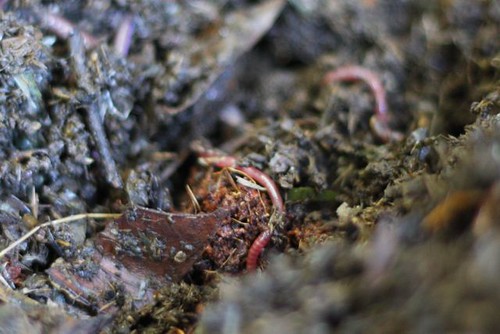This weekend gone by I finally had the spare change and time to buy some inhabitants. I contacted the most local worm farmer I could find and paid her the handsome sum of $35 for 1000 worms. I expected a large bucket-full or even a medium bucket-full of squiggling worker-worms but instead found that 1000 worms fit easily into two Chinese takeaway containers.
The first step in setting up the farm was to give the worms some bedding. Nothing so easy! The 'Can of Worms' comes with a block of coir, shredded coconut husks, to use as bedding. When immersed in a bucket of water the brick expands and can be broken apart to form the worm bedding. You can see in the picture above the beautiful texture of the coir.
The worm condo was now fully set up for its first squiggly inhabitants so I introduced the worms to their new home. They seemed to like it well enough, diving into the coir away from the sunlight. It was only a matter of seconds before they were all hidden away but I managed to get a few photos first.
 Worms quickly escaping underground from the sunlight.
Worms quickly escaping underground from the sunlight."Why worms?" I've had a few of my friends ask.
Because worms turn kitchen scraps into castings - or worm poop - which is a glorious, organic fertiliser, safe for direct use on the garden. The liquid that gathers in the bottom catcher tray of the worm farm can also be used as a liquid fertiliser. Kitchen scraps that would become methane in landfill instead become part of a natural and healthy cycle.
Because worms will multiply, given time, and can be used for fishing, or be given to our chooks-in-planning as extra-special treats. With enough worms I could even sell on the worms to others.
Because 1000 worms and a worm farm cost me just over $100 but will provide so much back, not just in the form of compost but also as an interesting project, as a way to learn and, as I've already discovered, a path to patience. Nothing happens quickly in a worm farm, with perhaps the exception of their retreat away from sunlight. Waiting for visible results is going to take some patience!

It looks so cute; in a gardeny sort of way. But I have to say worms are one of those animals that creep me out. Do not ever EVER make me touch one. *shudder*. It's great though that you are getting more into the garden.
ReplyDelete:D They're not so bad. I'd rather touch a worm than a frog or toad. *shudder* Cane toads are my worst enemies!
ReplyDelete